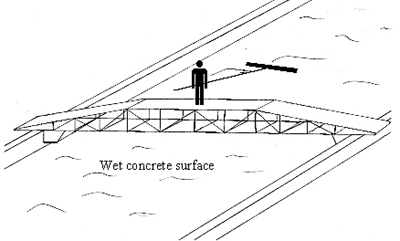- Standard Number:
OSHA requirements are set by statute, standards and regulations. Our interpretation letters explain these requirements and how they apply to particular circumstances, but they cannot create additional employer obligations. This letter constitutes OSHA's interpretation of the requirements discussed. Note that our enforcement guidance may be affected by changes to OSHA rules. Also, from time to time we update our guidance in response to new information. To keep apprised of such developments, you can consult OSHA's website at https://www.osha.gov.
December 9, 2002
ATI–Advance Technology, Inc.
Attn: Mr. Thomas A. Berry
1762 North St. Francis
Wichita, Kansas 67208
Re: Whether fall protection is required for workers on work bridges; whether workers on work bridges must be protected against impalement on vertical rebar; §§1926.450(b) and 1926.701(b); work bridges; scaffolds; concrete; rebar
Dear Mr. Berry:
This is in response to your March 6, 2002 letter to the Occupational Safety and Health Administration (OSHA) regarding "work bridges" used in concrete construction work. You explained that these are made by several manufacturers. Your letter stated that concrete finishers use these work bridges as work platforms during pouring operations for bridges andhighways. We apologize for the long delay in responding to your request.
We have paraphrased your questions as follows:
Question (1): Is a guardrail (or other fall protection) required for workers on work bridges to prevent falls into the concrete and off the work bridge ends?

Work bridge (conceptual illustration)
Answer
As we understand it, in a typical situation, a worker stands on the work bridge to be able to screen the poured concrete surface. In general, work bridges are narrow (in some cases 1½' wide) and may be several feet to 60 or more feet long. You note that one manufacturer's brochure states that its work bridge is not to be used as "scaffolding."
OSHA's scaffold standard applies when working from work bridges
OSHA's scaffold standard for the construction industry, 29 CFR Part 1926, Subpart L (specifically, §1926.450(b)), defines a scaffold as "any temporary elevated platform (supported or suspended) and its supporting structure (including points of anchorage), used for supporting employees or materials or both." Irrespective of a manufacturer admonition not to use them as "scaffolding," work bridges are used as temporary work platforms for employees. Their use is therefore subject to the requirements of Subpart L.
OSHA's scaffold standard requires fall protection for employees exposed to falls of 10 feet or more
Under §1926.451(g), fall protection is required for employees on scaffolds where the fall hazard is over 10 feet. So, guardrails or other fall protection must be provided where a fall hazard at the ends of the work bridge is over 10 feet, or where the fall hazard into the wet concrete is over 10 feet.
Question (2): In some instances, workers on the work bridge are 1-3 feet above freshly poured concrete with vertical rebar below the surface of the wet concrete. Are such workers required to be protected from the impalement hazard posed by the rebar?
Answer
Yes. OSHA's standard for concrete construction, 29 CFR Part 1926 Subpart Q, specifies in §1926.701(b), that "all protruding reinforcing steel, onto and into which employees could fall, shall be guarded to eliminate the hazard of impalement." Unprotected vertical rebar beneath the surface of freshly poured concrete presents an impalement hazard, since the still-liquid concrete would not prevent a falling worker from being impaled (vertical rebar that has been properly capped or bent over 90 does not present an impalement hazard). One way of providing impalement protection with respect to the vertical rebar behind the worker would be to install a second work bridge behind the worker to prevent him/her from falling backward onto the rebar.
With respect to the impalement hazard posed by falling forward, there may be instances where an employer can demonstrate that the only feasible means of protection is the use of a guardrail. If in such instances the employer also demonstrates that a toprail at the height required by §1926.451(g)(4)(ii) would prevent the use of the screed, a lower toprail normally would be considered acceptable.
If you need additional information, please contact us by fax at: U.S. Department of Labor, OSHA, Directorate of Construction, [Office of Construction Standards and Guidance], fax # 202-693-1689. You can also contact us by mail at the above office, Room N3468, 200 Constitution Avenue, N.W., Washington, D.C. 20210, although there will be a delay in our receiving correspondence by mail.
Sincerely,
Russell B. Swanson, Director
Directorate of Construction

